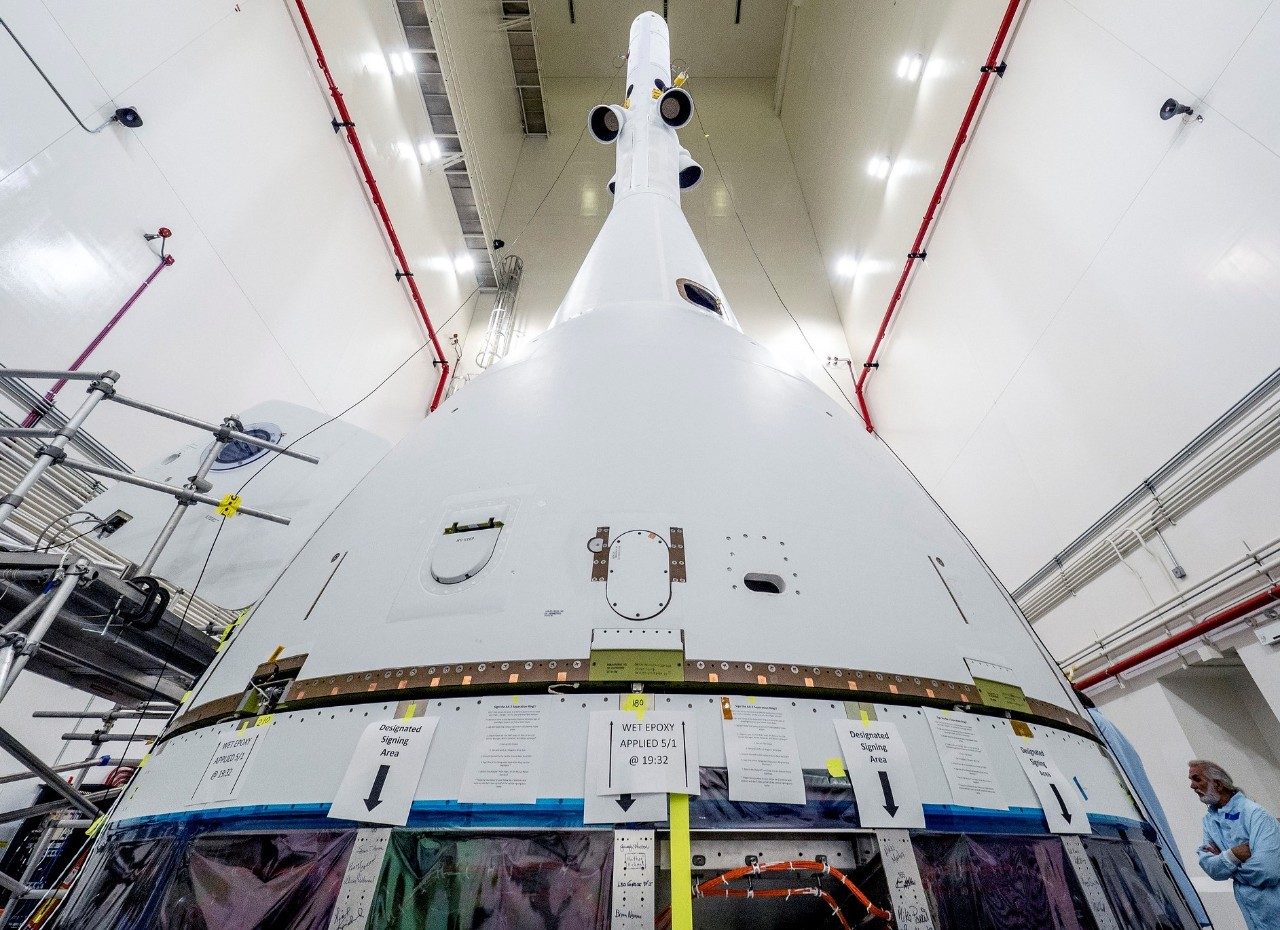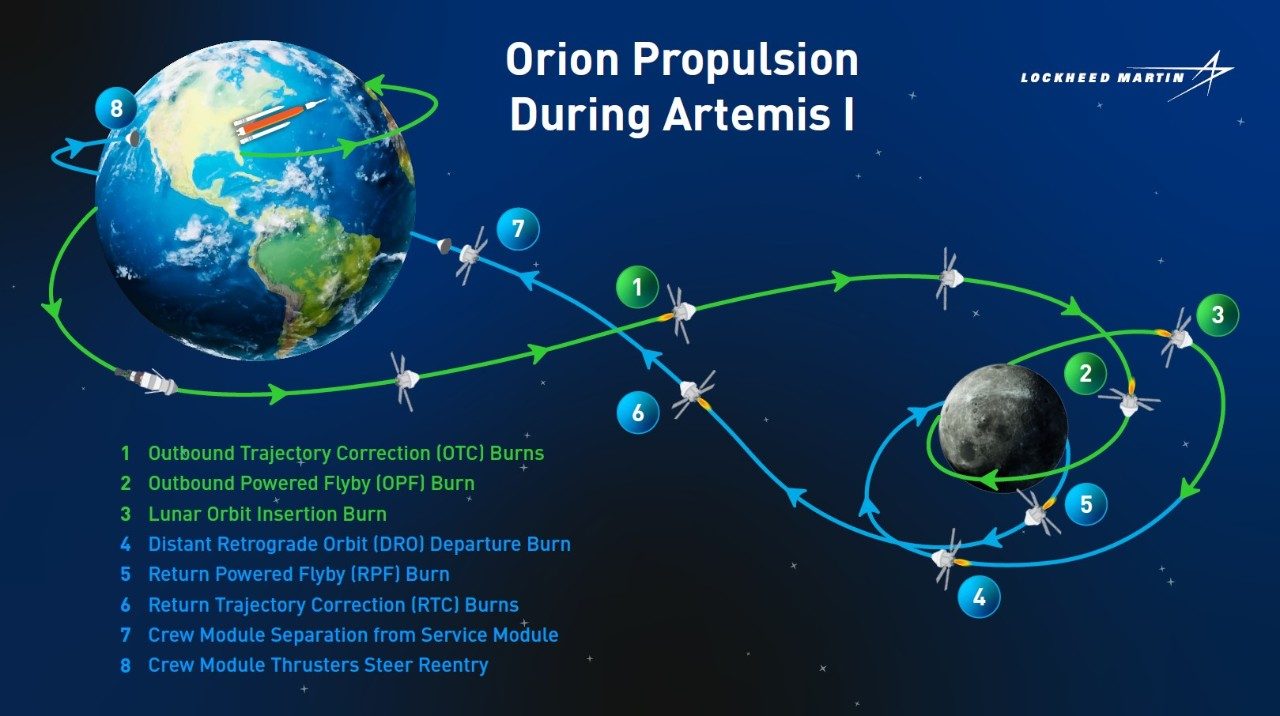The world’s most powerful rocket – the Space Launch System (SLS) – is responsible for launching NASA’s Orion into space, but it’s a series of smaller propulsion engines and motors that allow the spacecraft to navigate its way around the Moon and back to Earth.
The Lockheed Martin-built Orion couldn’t usher us into the next era of human space exploration without these intricate propulsion systems, which are used to accelerate or decelerate the spacecraft in desired directions.
The Orion spacecraft is composed of three main elements, all of which have their own propulsion systems to control the spacecraft’s trajectory and attitude during various stages of the Artemis missions. Those elements are the launch abort system, the service module, and the crew module.
Launch Abort System
The launch abort system is designed to pull the Orion spacecraft and its crew to safety in the event of an emergency during launch or ascent to orbit. It’s shaped like a needle, sits atop the crew module, and has three different propulsion elements.
One element of this system is the abort motor, which fires in an abort scenario to pull the crew module away from danger or hazard if something goes wrong with the launch vehicle. Another element is the attitude control motor, which would fire after the abort motor to control the orientation of the crew module and steer it away from the launch vehicle. Lastly, there’s the jettison motor, which separates the launch abort system from the crew module.
“The jettison motor actually fires every flight, not just in an abort scenario,” said Eric Coffman, Lockheed Martin Orion propulsion senior manager. “So, if everything goes well during the launch, the jettison motor will still fire and pull the launch abort system away from the Orion vehicle.”
One significant difference between the launch abort system and the crew and service modules is the use of solid rocket motors compared to liquid propulsion engines. The launch abort system uses solid motors, while the crew and service modules use liquid-fuel engines.

Service Module
The service module is equipped with Orion’s main propulsion system, the powerhouse that fuels and propels the spacecraft on its journey. This module is also responsible for orbital maneuvering and position control, as well as critical functions like thermal control and electrical power generated by solar arrays.
The service module is located beneath the crew module and is designed to support long-duration missions to deep space destinations. It’s equipped with a total of 33 engines: one main OMS engine (OMS-E), eight auxiliary engines, and 24 reaction control thrusters.
The OMS-E is a reused space shuttle engine that performs most of Orion’s large translational and trajectory correction burns. This engine provides major in-space maneuvering capabilities throughout missions, including inserting Orion into a distant retrograde orbit around the Moon and also firing powerfully enough to depart the Moon’s orbit to return to Earth.
The eight auxiliary engines are smaller than the OMS-E, but they’re also used for translational and trajectory correction burns, essentially serving as a backup for the main engine.
The even smaller 24 reaction control thrusters are used to steer and control Orion, making sure it’s pointed in the right direction.
“The service module is the largest and most complex of the three systems, but all of Orion’s main three elements have their own unique challenges and specialties,” said Coffman.
Crew Module
The crew module is where astronauts live and work. It has a propulsion system composed of 12 monopropellant engines, called reaction control system thrusters. These thrusters are used to steer the Orion capsule as it reenters Earth’s atmosphere at the end of the mission.
When the crew module separates from the service module for reentry, the 12 thrusters control the spacecraft’s return by firing bursts of propellant in varying sequences.
During this guided flight phase, the thrusters steer the spacecraft, keeping the heat shield down and making sure the capsule is in the right orientation to prevent the crew module from burning up during reentry.
Timeline of Orion Propulsion

Below is an outline of some of Orion’s most important burns during the Artemis missions:
Orion launches on the SLS rocket
- Orion’s launch abort system separates from the crew module during launch
Once in space, the SLS upper stage sends Orion on its trajectory towards the Moon with a trans-lunar injection burn
- After separating from the SLS rocket, Orion’s service module does outbound trajectory correction burns to adjust its course for the Moon
- The service module performs an outbound powered flyby once it nears the Moon
- The service module performs a lunar orbit insertion burn to slow down and enter a distant retrograde orbit around the Moon
- To exit lunar orbit, the service module performs a distant retrograde departure burn to speed up and break away from the Moon’s gravity
- The service module performs a return powered flyby burn, which prepares for the return to Earth
- On the way back to Earth, the service module performs return trajectory burns to correct Orion’s course home
- When Orion reaches Earth, the crew module separates from the service module and enters the atmosphere
- The crew module reaction control thrusters steer the crew module through guided power flight on its trajectory to the landing site
Orion splashes down in the Pacific Ocean within view of a recovery ship
Learning for Future Missions
With Artemis I being a test flight, the Orion propulsion team at Lockheed Martin is hoping to apply what they learn from this mission to their work on Artemis II and beyond.
“We’ll be looking to understand if the performance of the propulsion systems matches the tests that we ran on them prior to flight,” said Coffman. “Did it match the analysis models that we developed? Did we encounter anything unexpected or encounter any anomalies during the mission? It’s those kinds of things that we’ll be looking for and looking to learn from during the Artemis I mission to carry forward into Artemis II.”
Looking to the future, Orion’s design and configuration will essentially be the same for Artemis II, but one difference involves the launch abort system. For Artemis I, the abort motor and attitude control motor are inert, or inactive, because there’s no crew on board. Those motors will be active for Artemis II to protect the astronauts who will be traveling in the spacecraft during that mission.
With more missions on the horizon, Lockheed Martin’s propulsion team is excited to keep propelling Orion forward to the Moon and eventually Mars.




